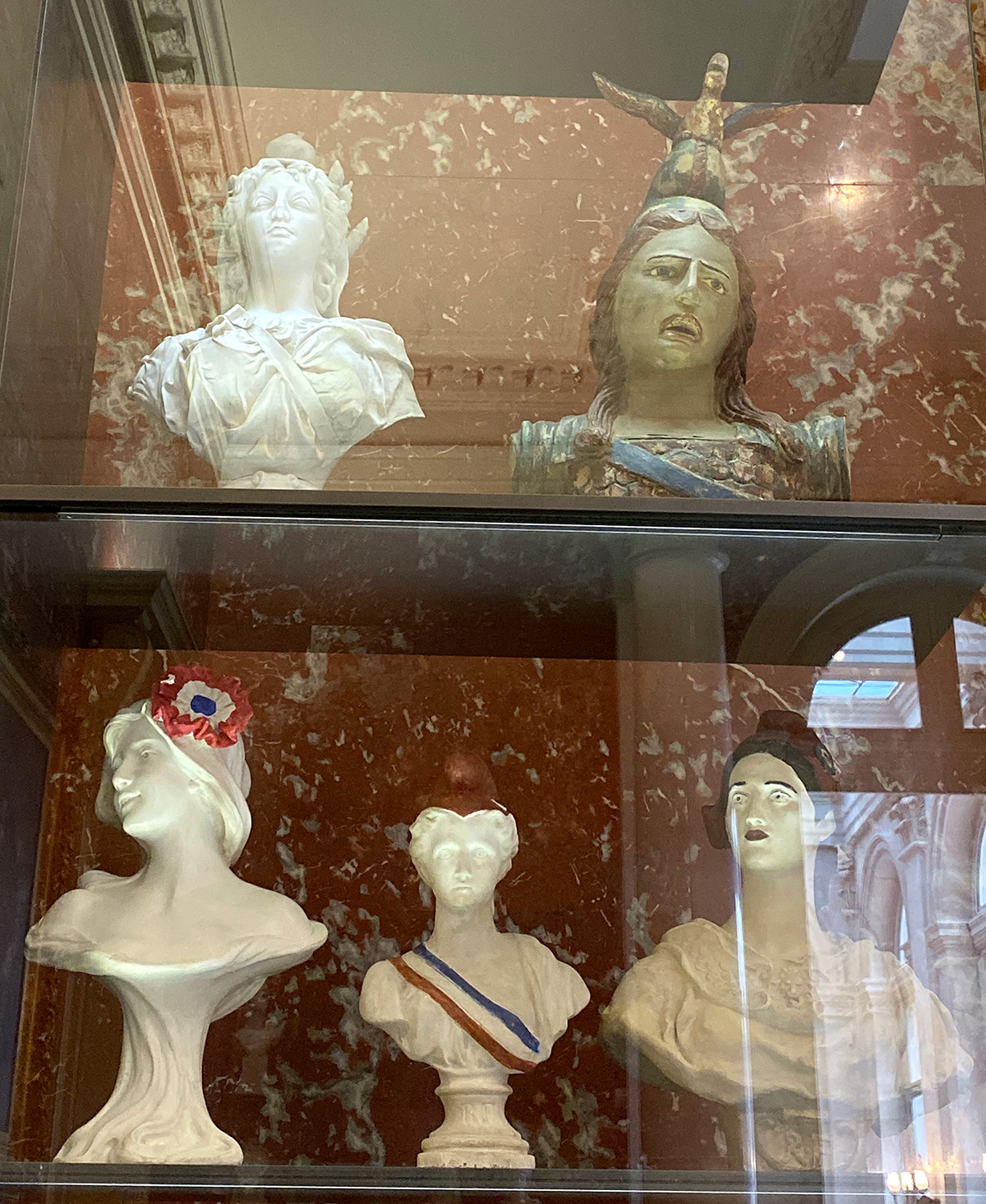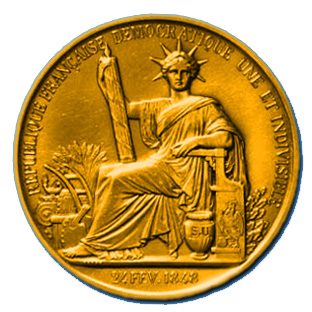Symbols and emblems of France
The symbols and emblems of a country are defined by their constitution or simply by usage. Thus France has only one official symbol, the flag. There are of course also the national anthem, the language and the motto which are official and designated in the Constitution. France also has several other symbols that have come into use over the years such as Marianne, the fasces and the rooster. In this article we’ll present the history and development of the official and non official symbols of France.
Article II de la Constitution:
La langue de la République est le français.
L’emblème national est le drapeau tricolore, bleu, blanc, rouge.
L’hymne national est la « Marseillaise ».
La devise de la République est « Liberté, Égalité, Fraternité ».
Son principe est: gouvernement du peuple, par le peuple et pour le peuple.
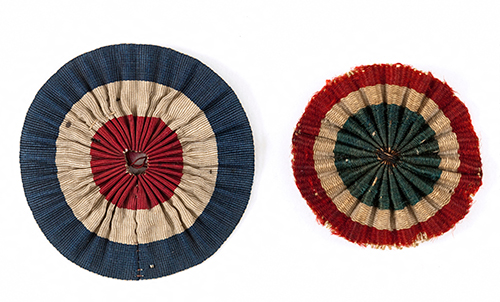
Cocardes. Paris, musée Carnavalet.
Crédit photographique : © Eric Emo / Musée Carnavalet / Roger-Viollet
The flag
The flag of France was not designed in one linear process as with some more recently independent countries. It developed organically over time from the flags flown over naval ships and through the revolutionary rosette (called cocarde in French). No one can even pinpoint when or why the three colors of blue, white and red were chosen. The commonly taught story that the blue and red were the colors of Paris and white respresented the king has been revised by scholars. Michel Pastoureau, one of the authors of the book Les Couleurs de la France (editions Hoëbeke, 2017) suspects that the colors might stem (unofficially of course) from those of American flag (which in turn was perhaps designed as a contra-flag to Britain’s Union Jack). The American revolution was an important event that just preceded the use of the three colors during the French revolution. Another color hypothesis comes from Bernard Richard, history professor and author of Petite histoire du drapeau français, who underlines that red and blue had been the colors of Paris since the 12th century. Red was for the bishop of Paris who was the successor to Saint Denis, the first bishop and martyr (martyr red) and blue for the King of France who had chosen the Virgin Mary as the patron of his kingdom (Mary is symbolized by blue which was once the color of mourning). So blue and red were the colors of the National Guard led by La Fayette and to which was added white for royalty (white being the traditional color of Saint Michael since the 14th century).
During the period between the American revolution and the French revolution the three colors were already fashionable with men and women in ribbons and rosettes on clothing and hats in France. The rosette, originally used on military uniforms, took on a new significance during the revolutionary period as people began wearing them to show allegiance to ideas or groups rather than just as decoration. Camille Desmoulins, during a speech on 12 July 1789, proposed that those who supported the patriots wear a rosette. He pulled a handy leaf from a nearby tree and pinned it to his hat during a zealous speech. The idea caught on like wildfire, but the next day the revolutionaries realized that green was the color of the Count d’Artois – one of the hated royals – thus the rosette color was changed to tricolor. Perhaps La Fayette or Bailly, the mayor of Paris, had the idea to fusion the colors of the king (white) and the red and blue of the national guard. Another source suggests the idea came from the king himself in a gesture of reconciliation. In any case the colors caught on and were soon seen on belts, scarves and flags carried by the revolutionaries. In 1790 a national tricolor rosette was proclaimed. There was no particular organization of the three colors at the time, but white was often in the center. Progressively tricolor flags became official, but some had horizontal stripes, some vertical and there were many different shapes. Things were clarified in 1794 when it was decided that ships would use a flag of three bands of equal widths with blue next to the pole. The maritime flag progressively became the de facto national flag and came and went in popularity throughout the 19th century; used during the various uprisings and republics, but banished during the monarchies and empires. The flag was not officially defined until the 1958 constitution. The shades of the three colors are still not specifically defined and can vary largely in usage from poppy to brick and cyan to cobalt.
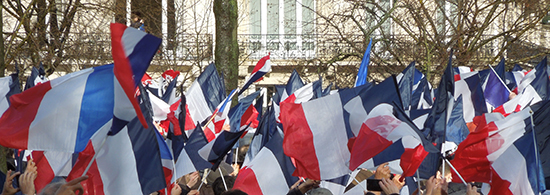 There is a specific way to fold the French flag: Fold in first the red, then the blue thirds to cover the white, then fold in half the other direction so that only the blue is visible.
There is a specific way to fold the French flag: Fold in first the red, then the blue thirds to cover the white, then fold in half the other direction so that only the blue is visible.
There are also specific days to fly the flag:
19 March – Remembrance of the victims of the Algerian war
Last Sunday in April Remembrance of the Deported
8 May – Victory 1945
9 May – Europe Day
2nd Sunday in May – Joan of Arc Day
27 May – Resistance Day
8 June – Homage to the victims of the Indochina war
18 June – Commemoration of the 1940 call to resistance by General de Gaulle
14 July – National holiday
16 July – In memory of the victims of anti-semitic and racist crimes as well as Les Justes
25 September – Homage to the Harkis
11 November – Armistice of WWI
5 December – Remembrance of those who died for France in Algeria, Morocco and Tunisia
The Marseillaise
Following France’s declaration of war on Austria and Prussia, the mayor of Strasbourg, Baron de Dietrich, asked army engineer who was apparently also a musician, Claude-Joseph Rouget de Lisle, to write a marching song. On the night of April 25th 1792, Rouget de Lisle penned the Chant de guerre pour l’armée du Rhin – War song for the Rhine Army, named in honor of the garrison to which he belonged. The song was meant to inspire the army to be strong in the face of the invader’s tyranny.
The song was republished under the name of Chant de guerre aux armées des frontières – by François Mireur, who was in Marseille to organize a march of revolutionary volunteers on King Louis XVI’s Tuileries palace. The revolutionaries adopted the song and sang it with fervor as they entered Paris, on July 30th 1792. The Parisians thus named it La Marseillaise.
It was declared the national song on July 14th 1795 but then banned during the Empire. The July revolution of 1830 reinstated it, and it was rearranged by Hector Berlioz. It was adopted as the national anthem under the Third Republic in 1879. The Marseillaise has seven verses of which we usually sing just the first. Here is the first verse. To better understand the lyrics try your language skills on the Speak Easy game based on La Marseillaise below and for a complete translation to English see www.marseillaise.org
Allons enfants de la Patrie
Le jour de gloire est arrivé !
Contre nous de la tyrannie
L’étendard sanglant est levé
Entendez-vous dans nos campagnes
Mugir ces féroces soldats?
Ils viennent jusque dans vos bras.
Égorger vos fils, vos compagnes!
Aux armes citoyens
Formez vos bataillons
Marchons, marchons
Qu’un sang impur
Abreuve nos sillons
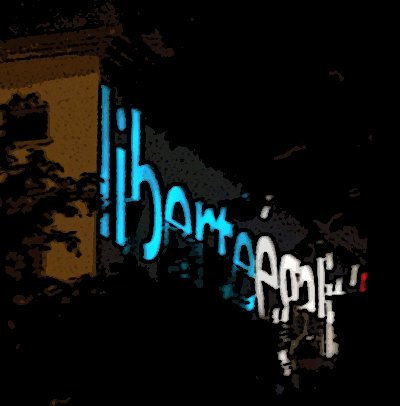 The motto: « Liberté, Égalité, Fraternité »
The motto: « Liberté, Égalité, Fraternité »
It has been suggested that Fénelon, François de Salignac de La Mothe-Fénelon, who was a French clergyman, theologian and writer at the end of the XVIIème century, wrote the notions of Liberty, Equality and Fraternity. Fénelon’s novel Les Aventures de Télémaque (1699) is considered a critique of Louis XIV’s politics and was a precursor to the Enlightenment. During the French revolution this motto was one of many suggested. Like many revolutionary symbols the motto went in and out of favor during the 19th century. The motto was officialized in the constitutions of 1946 and 1958.
- Liberty is the notion of the absence of constraint, but also that individual liberty stops at the point where the liberty of others begins.
- Equality is the notion that each person has the same rights and responsibilities.
Tous les êtres humains naissent libres et égaux en dignité et en droits (article 1er de la Déclaration universelle des Droits de l’Homme)
- Fraternity is the notion that there is a link of solidarity and friendship amongst all humankind
Other symbols of France that are not part of the constitution include the rooster, Marianne, the great seal and the Lictor’s fasces.
Rooster
There is no more prevalent symbol of France than the rooster. Today the rooster symbolizes (unofficially, but frequently) France and the French. He often appears in international sporting events acting as the mascot for French teams or on uniforms; has marched in the opening ceremonies of the Olympics; is on postage stamps and carousels and in countless idiomatic expressions. «Cocorico» is the French onomatopoeia for the rooster crowing sound cock-a-doodle-doo and also used to express national pride (often with a touch of irony). Read about how the rooster became a symbol of France.
« Savez-vous pourquoi les Français ont choisi le coq comme emblème ? C’est parce que c’est le seul oiseau qui arrive à chanter les pieds dans la merde ! » — Coluche
Marianne
The first depictions of a woman in a phrygian cap as an allegory of liberty and the republic date from the French revolution in 1792. The phrygian cap is a soft conical cap, a bit elfin one might say. It was worn historically by several peoples in Eastern Europe and Anatolia, including Phrygia – hence the name. It came to signify freedom and the pursuit of liberty as it was similar to the felt cap given to and identifying emancipated slaves of ancient Rome. Why lady liberty was named Marianne is however rather uncertain. Marie and Anne were very common first names during the 18th century and the contraction was often use to mean “the people”. Under the Third Republic statues and busts of Marianne popped up in nearly every town hall. Sometimes she was sculpted with a diadem or crown rather than the revolutionary phrygian cap. The face of Marianne today is based on that of prominent women such as Brigitte Bardot, Catherine Deneuve and Laetitia Casta who are chosen by the Association of Mayors of France. Marianne is seen most often on postage stamps, but also on coins and the logotype on Republic’s documents. Read about Marianne on the postage stamp.
14 Juillet
The French national holiday is not called Bastille Day in France. While it is true that the storming of the Bastille happened on 14 July 1789, the following year that date was another important event: the first Fête de la Fédération. This event was a grand reconciliation held on the Champs de Mars. Everyone was present: the king, the deputies of the constitutional assembly, the federalists and the people. 14 July was made the official national holiday only in 1880 after long debate as to what day to choose for the national day. In the law designating the day there was no mention as to which event – the Bastille or the Fête – was to be commemorated. It seems that the 14th of July was chosen as it was at a convenient time of year and did not offend any particular group, nor put any particular group in the forefront of commemorations. The first official 14 juillet 1880 was a day off work for all to celebrate patriotism and included a military parade, marching bands, fireworks, dancing and orchestras. The same scenario was played out all over France. Sound familiar?!
Lictor’s fasces (Faisceau de licteur)
This symbol is the least well known. It is an image or bas relief of long thin branches wrapped by a leather thong. This fasces represents the indivisibility of the republic. In front the fasces is the republican shield with the letters RF (République Française) and branches of oak (justice) and olive (peace). In ancient Rome a fasces was carried by the lictor who was the person who executed the magistrate’s laws. Once again this symbol was first selected during the revolution and came and went during the following years. The lictor’s fasces is found on passports and other official documents as well as on buildings. It is also the emblem of France at the United Nations. A fasces is also widely used in the United States.
The seal of France is used now only on documents of great importance such as a modification to the constitution. The current seal, created in 1848, depicts a seated woman – Liberty – holding a lictor’s fasces in her right hand and in the left a rudder on which there is a rooster with his foot on the globe. An urn with the initials SU for suffrage universel, the symbols of the arts and agriculture and the words « République française démocratique une et indivisible » complete the seal. You can see it on the plaques of Notaries and on the façades of courts of law. The minister of justice is called the Garde des sceaux because the press for the seal (sceau) is kept at the ministry. The official seal of Louis XVI was made of gold and melted during the revolution to reuse the gold.
Bonus:
Unofficially the national flowers of France are blue, white and red of course. They are: the cornflower, daisy and poppy. (le bleuet, la marguerite et le coquelicot)
French was officialized as the language of France by an addendum to the constitution in 1992.


